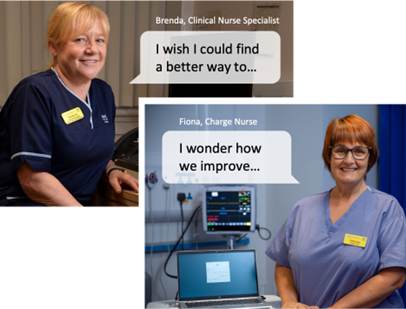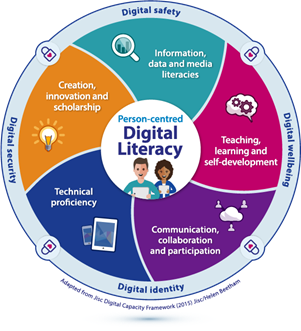- Do not assume staff are digitally literate
- Define a framework of recommended core digital skills for all staff. This may be through adopting a model such as that illustrated above, or developing an approach specifically for NHSGGC.
- Support services to identify and define a framework of recommended digital skills specific to their area
- Support services to evaluate the digital literacy of their staff to enable a conversation on learning for digital success
- Embed the adoption of these recommended digital skills in recruitment, induction, and the learning and development process
- Provide easy to find learning resources that are accessible for staff to develop the recommended digital skills specific to their role
- Provide the tools and technologies required for staff to work at their best digital capacity
- Identify leaders and champions, and the skills they require
- Promote an “I need digital to do…” approach
Workforce and digital literacy skills


Supporting staff to be digitally literate is a key theme of this strategy. Digital literacy is defined as, “those capabilities that fit someone for living, learning, working, participating, and thriving in a digital society".
These capabilities extend beyond just technical proficiency in, for example, using a specific clinical system, but include more conceptual and transferrable skills and knowledge such as data use, digital safety, and having a “digital-first” approach to quality improvement. Several models exist that categorise them, such as:

It is the broad nature of these capabilities that make digital literacy foundational for all staff working in modern healthcare settings so that the best quality person-centred care can be achieved. Knowing which tools to use, and when, can support the delivery of care. This is particularly important with the implementation of new systems such as eRostering.
While many learning resources already exist to support staff in developing these skills and capabilities, it can be difficult to choose the best ones and know where to find them, so it is imperative that we outline our expectation of these.
This digital strategy has been developed in line with the NHSGGC Workforce Plan and eHealth Workforce Plan. The workforce plan includes a key focus on the development of digital literacy across the workforce to maximise the benefits of existing and new technology.
There will be a new eRostering system implemented across NHS Scotland to improve the existing rota system and processes plus providing on line access to shifts for staff.
NHSGGC has a diverse workforce with a wide variety of accessibility needs. Due to the increasing use of technology in the workplace, digital accessibility is equally as important as the need to ensure physical access for everyone.
Digital accessibility involves supporting specialist technologies, such as voice-to-text dictation, speech readers and colour changing digital overlays. Other important aspects involve adhering to accessibility standards when procuring and creating digital solutions, and providing the ability to change fonts and font sizes when required.
We will introduce a structured approach that caters for the needs of individuals by grouping digital accessibility needs. This will ensure we are better able to cater for needs related to vision, hearing, dyslexia, dyscalculia, dyspraxia and others. A register of assistive software in use will be created to help us better respond to support requests and reduce the risk of disruption for staff when updating our systems. We will work closely with suppliers to anticipate accessibility challenges and to maximise the value of available assistive technologies. Accessibility standards across our systems and software will be adopted where possible, including a standard typeface and font size. Cornerstone systems will continue to be reviewed regarding accessibility standards.
Our new eHelp system will be enhanced to provide short-form ‘Micro-Learning’ materials to help staff understand specific system features and functions, as an accessible alternative to long-form user guides. Technologies such as laptops and tablets with touch screens, assistive software, and multiple displays will be utilised to better meet individual staff needs.
Procurement and development of digital solutions will assess accessibility features and adherence to standards, improving the experience for staff with disabilities. Additional information will be provided to staff about the availability of accessibility tools and technologies, and how staff can access information about accessibility settings and core digital literacy and skills.
Additional Technology and Digital Strategy training modules are about to be implemented which will introduce administrative staff to the different systems, apps and tools on our technology menu, delivered in ‘bite-sized chunks’. Options will continue to be explored for digital adoption methods and technologies to help our workforce understand and make effective use of systems, with the aim of having the best-trained, most professional, and digitally proficient workforce possible.
